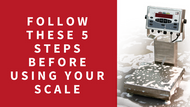Follow These 5 Steps Before Using Your Scale Every Time
Posted by Seth V on May 22nd 2018
Setting up a scale properly before each use is important to help avoid operator errors, inaccurate readings, quality issues and loss of profits. Simply switching on the power and getting right to it can have disastrous results if the scale isn't working at optimum efficiency. Following these 5 simple steps before using your scale can make all the difference.
1.) Inspect Your Workspace
A clean and ample sized work space is important. Start by making sure you have plenty of room to use the scale. Any objects that could come in contact with the weighing surface or inhibit your ability to properly position samples will cause issues. Make sure the scale is clean, as well as the area around it. Debris can cause internal and external damage, resulting in down-time and potentially expensive repairs.
While you're at it, make sure the surface you're working on is sturdy and stable. A shaky table, desk or crooked work station can cause inaccurate readings. Also try to use a space that is specifically designated for weighing. Vibrations from other operations on the same surface can cause drifting.
Environmental factors should be considered as well, especially drafts. Drafts from movement around the scale and climate control can effect measurements. Depending on readability and accuracy, even a slight breeze could effect the reading. When drafts aren't easily detectable, a simple test can determine if they exist. Just turn on your scale and check for display drifting. If you suspect there is some disturbance, try placing a draft shield or barriers around the scale to prevent draft.
2. Check for Binds
Checking for binds is something that is often missed. An internal bind is when an object blocks your weighing mechanism from operating freely. These kinds of binds are most often caused by debris under the weighing pan. When possible, remove the pan and do a visual inspection. If any debris is present, remove it carefully, following the manufacturer's guidelines.
External binds can be caused from something as simple an object leaning against the scale or pan. Best practice is to ensure that nothing comes into direct contact with any portion of the scale during use.
3. Inspect Power Supply
Before operation you will need to ensure that you have the correct power supply. First and foremost, make sure it is plugged in. You wouldn't believe how often folks forgot to check that when a scale won't turn on. Beyond that, one of the most common issues with scale performance is a faulty or damaged power supply. Check to make sure you're using the right adapter and plug and visually verify there are no knots or breaks in the cord.
If you're using a battery operated unit, make sure that it is charged before beginning. As a best practice, have spare batteries on hand and keep them charged for backup. A little preparation can prevent a bunch of down time. Charge those batteries!
4. Level Your Scale
Leveling your scale before and during operation is extremely important. Most scales come with a leveling bubble and adjustable feet. Get it as level as you can before you do anything else. Even a slight incline or decline can effect weighing results. It is especially important to maintain level when performing a calibration. NEVER calibrate a scale that is not perfectly level.
Related Read: Importance of Leveling a Scale
5. Verify Accuracy
If you have test weights, check that the calibration is within tolerance. Use approved test references to verify the scale is performing properly. If the scale is out of tolerance, perform a calibration and check that the scale is now accurate. If your internal quality procedure calls for it, this is a good time to note whether or not the scale has been inspected on schedule. Often times, service companies provide scheduled calibrations and will place a sticker on the unit with it's last service and next due date. If you notice service is past due, make a note of it and get it taken care of as soon as possible.
Summary Checklist
- Is your workspace clean and does it provide enough room to work?
- Is your work surface sturdy and solid?
- Are there any drafts that could effect weighing?
- Is your scale free of any and all binds?
- Is the power supply in good condition and plugged in?
- Is the battery charged (where applicable)?
- Is your scale level?
- Is your scale calibrated correctly?
- Is your scale overdue for a calibration?





